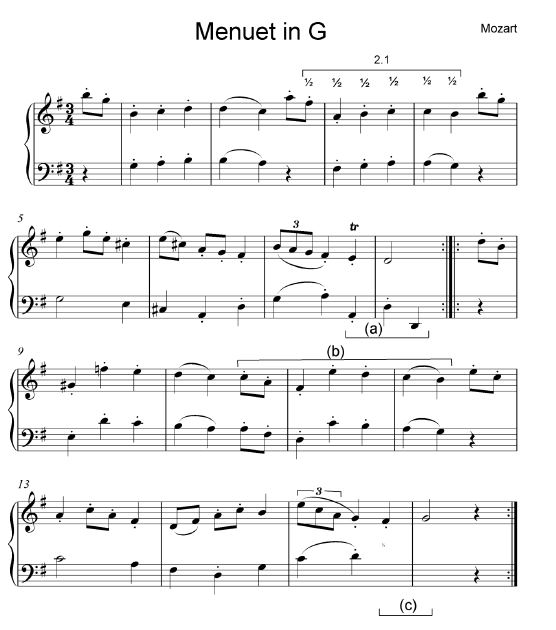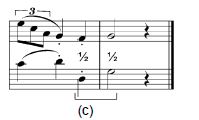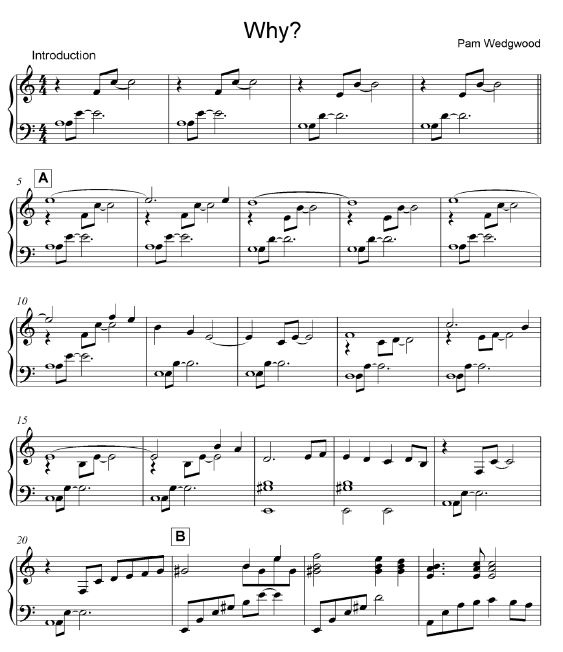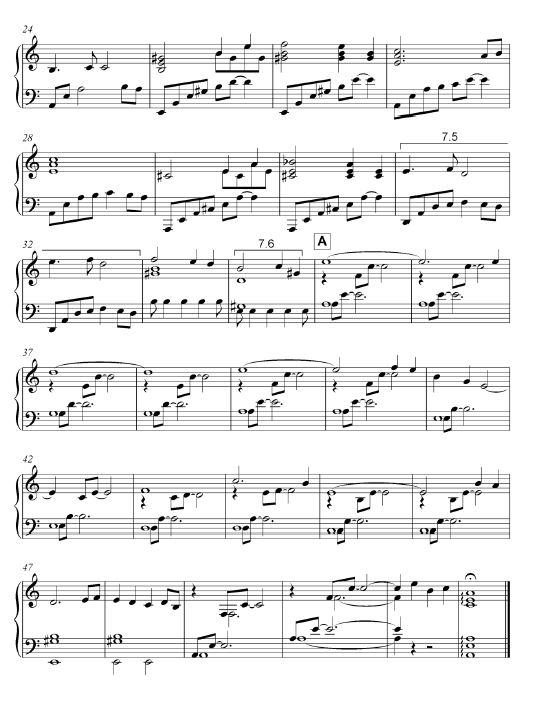MUSIC PAPER 2 GRADE 12 MEMORANDUM - NSC PAST PAPERS AND MEMOS FEBRUARY/MARCH 2017
Share via Whatsapp Join our WhatsApp Group Join our Telegram GroupMUSIC
PAPER 2
GRADE 12
NSC PAST PAPERS AND MEMOS
FEBRUARY/MARCH 2017
INSTRUCTIONS AND INFORMATION
- This question paper consists of THREE sections:
SECTION A: Aural (10)
SECTION B: Recognition (12)
SECTION C: Form (8) - QUESTION 1, QUESTION 2, QUESTION 3 and QUESTION 7 are COMPULSORY.
- Answer QUESTION 4: Western Art Music (WAM) OR QUESTION 5: Jazz OR QUESTION 6: Indigenous African Music (IAM).
- Write ALL your answers on this question paper. Use a pencil for music notation and blue or black ink for the other answers.
- This examination will be written while candidates are listening to a CD. 6.
- The music teacher of the centre must conduct the examination in the presence of the invigilator.
- The last page of this question paper is manuscript paper intended for rough work. The candidate MAY NOT remove this page.
- Candidates may NOT have access to any musical instrument for the duration of this examination.
- Candidates must take note of the mark allocation at each question to provide enough information in their answers.
- Write neatly and legibly.
INSTRUCTIONS TO THE PERSON OPERATING THE SOUND EQUIPMENT
|
SUMMARY OF MARKS
SECTION A: AURAL | TOTAL |
QUESTION 1 (COMPULSORY) | 4 |
QUESTION 2 (COMPULSORY) | 6 |
SUBTOTAL | 10 |
SECTION B: RECOGNITION | TOTAL |
QUESTION 3 (COMPULSORY) | 4 |
QUESTION 4 (WAM) OR | 8 |
QUESTION 5 (JAZZ) OR | 8 |
QUESTION 6 (IAM) | 8 |
SUBTOTAL | 12 |
SECTION C: FORM | TOTAL |
QUESTION 7 (COMPULSORY) | 8 |
SUBTOTAL | 8 |
GRAND TOTAL | 30 |
Note to the marker: Candidates must be credited for any correct answers not given in the memorandum. |
MEMORANDUM
SECTION A: AURAL
QUESTION 1
Play Track 1 TWICE in succession. |
1.1 Listen to the melodic and rhythmic phrase. Notate the rhythm of the missing notes in bars 3–4 below.
Play Track 1 TWICE again. |
Answer: 
½ mark per note as indicated = 3 marks |
Play Track 2 THREE times in succession. |
1.2 Which ONE of the extracts below best represents the solo violin part? Make a cross (X) in the appropriate block.
 (1)
(1)
[4]
Play Track 2 ONCE more. |
Correct answer = 1 mark |
QUESTION 2
Play Track 3 ONCE to provide a general overview. |
Listen to the extract from Menuet in G by Mozart. Answer the questions that follow.
Play Track 4 TWICE. |
2.1 The notation of bars 23b–42has been omitted at 2.1 in the score. Fill in the missing pitches on the score that correspond to the music that you hear.
Answer: 
½ mark for each correct pitch = 6 X ½= 3 marks |
Play Track 5 ONCE. |
2.2 Name the cadence at (a) in bars 73–82. (The track starts in bar 1.)
Answer:
- Perfect (cadence) (1)
1 mark |
Play Track 6 ONCE. |
2.3 Listen to the music in bars 83–122. Which compositional technique is used at (b)? (The track starts in bar 83.)
Answer:
- Sequence
- Rhythmic repetition (1)
Any correct answer = 1 mark |
Play Track 7 TWICE. |
2.4 Complete the missing bass notes at (c) on the score. (The track starts in bar 123.)
Answer: (1)
½ mark for each correct pitch = 1 mark |
[6]
Play Track 8 for a final overview. |
TOTAL SECTION A: 10
SECTION B: RECOGNITION OF MUSIC CONCEPTS
QUESTION 3: GENERAL LISTENING (COMPULSORY)
Listen to the following tracks and answer the questions that follow.
Note to marker: if a candidate selected more than one item in a question, only the first item must be marked. |
Play Track 9 ONCE. |
3.1 Listen to the music and indicate ONE feature that you hear. Make a cross (X) in the appropriate block.
Answer:
- String ensemble (1)
1 mark |
Play Track 10 TWICE. |
3.2 Choose any ONE item in COLUMN A and briefly describe in COLUMN B what you hear.
Answer:
COLUMN A | COLUMN B DESCRIPTION |
Tonality | Major |
Vocal technique | Scatting (vocal nonsense-syllable singing)/ vocal improvisation/vocalise |
Voice type | Female voice/alto |
Correct answer = 1 mark |
(1)
Play Track 11 TWICE. |
3.3 Choose any TWO items in COLUMN A and briefly describe in COLUMN B what you hear.
Answer:
COLUMN A | COLUMN B DESCRIPTION |
Compositional technique | Call and response/Imitation/Repetition |
Harmony | Repeated pattern |
Time signature | 4/4 or 2/2 |
Correct answers = 2 marks |
(2)
Note to marker: if a candidate selected more than two items, only the first two items must be marked. |
Play Tracks 12 and 13 in succession. |
3.4 In Tracks 12 and 13 you will hear TWO different performances of the same piece. Compare these two extracts in terms of the following:
Answer: (4)
Track 12 | Track 13 | |
Instrumentation | Harpsichord | Piano, drums, bass |
Texture | Polyphonic | Polyphonic |
Style | Baroque | Jazz |
Use of Rhythm | Straight | Swing |
1 correct answer per comparison = 1 mark No ½ marks |
(8 ÷2) (4)
TOTAL SECTION B: 4
Answer QUESTION 4 (WAM) OR QUESTION 5 (JAZZ) OR QUESTION 6 (IAM).
QUESTION 4: WAM
4.1 Listen to the following extract and answer the questions that follow.
Play Track 14 ONCE. |
4.1.1 Name the work from which this extract has been taken.
Answer:
- Hebrides Overture
- Fingal's Cave (1)
Any correct answer = 1 mark |
4.1.2 Identify the tonality of this extract. Make a cross (X) in the appropriate block.
Answer:
- Major (1)
1 mark |
Play Track 15 ONCE. |
4.1.3 Describe the melodic line.
Answer:
- Legato/Smooth/Flowing
- Cantabile/in a singing style/Lyrical
- Rapid crescendos and decrescendos
- Constant ascending and descending line
- Played by cello section (2)
Any 2 correct answers = 2 marks |
4.1.4 Identify the cadence at the end of this extract.
Answer:
- Perfect cadence (1)
1 mark |
4.2 Listen to the extract from Mozart's The Magic Flute in Track 16 and answer the questions that follow.
Play Track 16 TWICE. |
4.2.1 Name the character who sings in this extract.
Answer:
- Sarastro (1)
1 mark |
4.2.2 What does this character represent in the opera?
Answer:
- Goodness
- Fatherhood
- Reverence (1)
Any correct answer = 1 mark |
4.2.3 Name the voice type that you hear in this extract.
Answer:
- Bass (1)
1 mark |
4.2.4 Suggest a suitable Italian tempo indication for this extract.
Answer:
- Adagio
- Largo (1)
Any 1 suitable Italian term = 1 mark |
4.2.5 Where in the opera is this extract sung?
Answer:
- Act 2
- Before Tamino is subjected to the trials (1)
Any correct answer = 1 mark |
4.2.6 Describe what is happening in the storyline at this point.
Answer:
- Sarastro sings of the ideals of the Brotherhood after Pamina pleads for mercy for her mother, the Queen
- Sarastro makes a plea to the Egyptian gods to assist Tamino during his trials ∙ (1)
Any correct answer = 1 mark |
4.3 Listen to the extract from Beethoven's Symphony No. 6 in Track 17 and answer the questions that follow.
Play Track 17 ONCE. |
4.3.1 Choose the term that refers to this extract. Make a cross (X) in the appropriate block.
Answer:
- Tutti (1)
1 mark |
Play Track 18 ONCE. |
4.3.2 Name the woodwind instrument which plays the high-pitched melodic fragment in this extract.
Answer:
- Flute (1)
1 mark |
4.3.3 From which movement of the Symphony No. 6 by Beethoven has this extract been taken?
Answer:
- First movement (1)
1 mark |
Play Track 19 TWICE. |
4.4 Describe TWO style characteristics that you hear in this extract.
Answer:
- Homophonic texture
- Regular phrasing
- Clear-cut cadences
- Melodic motifs used abundantly
- Concerto genre used (oboe and strings) (2)
Any 2 correct answers = 2 marks |
(16 ÷ 2) [8]
TOTAL SECTION B: 12
OR
QUESTION 5: JAZZ
5.1 Listen to the extracts and answer the questions that follow.
Play Track 20 TWICE. |
5.1.1 With which of the following styles would you associate this extract? Make a cross (X) in the appropriate block.
Answer:
- Modern jazz (1)
1 mark |
5.1.2 Identify the piece in this extract
Answer:
- Shebeen (by Hugh Masekela & The Union of South Africa) (1)
1 mark |
5.1.3 Name TWO artists that are associated with the music style in this extract.
Answer:
- Hugh Masekela (Trumpet)
- Jonas Gwangwa (Trombone)
- Caiphus Semenya (Alto saxophone)
Any 2 correct artists = 2 marks |
OR
- Hugh Masekela and The Union of South Africa (2)
Answer = 2 marks |
5.1.4 Identify TWO idiophones that are part of the rhythm section in the music in this extract.
Answer:
- Shakers
- Cow bell
- Cymbals
- Tambourine (2)
Any 2 correct answers = 2 marks |
5.2 Listen to the extract in Track 21 and answer the questions that follow.
Play Track 21 TWICE. |
5.2.1 Identify the jazz style in this extract.
Answer:
- Kwela (1)
1 mark |
5.2.2 Give reasons, related to the music, for your answer to QUESTION 5.2.1.
Answer:
- Cyclic chord structure
- Solo player with band
- Lively tempo
- Skiffle-like beat
- Jive/Swing rhythms
- Melodic material developed in improvisation
- Pennywhistle (3)
Any 3 correct answers = 3 marks |
5.2.3 Which jazz artist from the 1950s had an influence on this type of jazz?
Answer:
- Spokes Mashiyane
- Lemmy Mabaso
- Elias Lerole (1)
Any 1 correct artist = 1 mark |
5.3 Listen to the extract in Track 22 and answer the questions that follow.
Play Track 22 TWICE. |
5.3.1 Give reasons why you would regard the extract as a typical Cape jazz piece.
Answer:
- Rhythmic characteristics of amaXhosa music
- Ghoema beat
- Marching and Christmas band harmonies
- Banjo and guitar rhythms from Kaapse Klopse
- Specific playing style of piano
- Saxophone produces melody in a nasal tone with vibrato at the end of phrases
- Characteristics of Khoi-San mouth bow evident (3)
1 mark for each correct answer up to 3 marks |
Play Track 23 ONCE. |
5.3.2 Describe the style of saxophone playing in your own words.
Answer:
- It plays the melody
- Uses a scooping performance technique
- Plays in the middle register
- Nasal tone colour used
- Vibrato at the end of phrases (2)
Any 2 correct answers = 2 marks |
(16 ÷ 2) [8]
TOTAL SECTION B: 12
OR
QUESTION 6: IAM
6.1 Listen to the extracts and answer the questions that follow.
Play Track 24 ONCE. |
6.1.1 Identify the style of music in this extract.
Answer:
- Free Kiba
- Malombo
- African Jazz (1)
Any correct answer = 1 mark |
Play Track 25 THREE times in succession. |
6.1.2 Choose the order in which the instruments appear. Make a cross (X) in the appropriate block.
Answer:
Instrument order | |
Drums/Percussion, piano, bass guitar | |
Drums/Percussion, bass guitar, piano | x |
Drums/Percussion, piano and bass guitar |
Correct answer = 1 mark |
(1)
Play Track 26 ONCE. |
6.1.3 What is the role of the female voices in this song?
Answer:
- Backing vocals
- Response to the 'call' of leader (male)
- Fills in the harmony (1)
Any correct answer = 1 mark |
6.1.4 What typical African compositional technique is heard in this extract?
Answer:
- Call and response (1)
1 mark |
6.2 Listen to the following TWO tracks which will be played in succession and answer the questions that follow.
Play Track 27 and Track 28 ONCE in succession. |
6.2.1 The TWO extracts have a similar purpose or function. Explain the purpose and function of the music in these two extracts.
Answer:
- Religious or sacred purpose
- Ritualistic
- Communication with Ancestors/God
- Relate to African divinity (2)
Any 2 correct answers = 2 marks |
6.2.2 Indicate ONE group associated with Track 27. Make a tick (X) in the appropriate block.
ZCC | Amazayoni | Apostolic Church | Shembe |
Answer:
- Amazayoni (1)
1 mark |
Play Track 29 ONCE. |
6.2.3 Describe the use of rhythm in the membranophones.
Answer:
- Polyrhythms
- Syncopation
- Repetitive (1)
Any correct answer = 1 mark |
Play Track 30 ONCE. |
6.2.4 Describe the texture of this song.
Answer:
- Overlapping voices
- Call and response (1)
Any correct answer = 1 mark |
Play Track 31 THREE times. |
6.3 Listen to the extract below and answer the questions that follow.
6.3.1 With what indigenous South African music style would you associate this extract?
Answer:
- Isicathamiya (1)
1 mark |
6.3.2 Which music performance characteristics heard in this extract, are common to the style of music in 6.3.1?
Answer:
- Overlapping voices
- Male choir/ensemble
- Use of falsetto
- Repetitive cyclic harmonic progressions (3)
1 mark for each correct answer up to a maximum of 3 marks |
Play Track 32 ONCE. |
6.4 Identify the style of music in this extract. Give TWO reasons for your answers.
Answer:
- Style: Mbaqanga
Reasons:
- Small ensemble of players
- Use of repetitive guitar melodic riffs
- Interweaving electric guitar lines repeated throughout
- Guitar introduction
- Guitar strings have a soft tone quality on electric guitar
- R&B fused with the cyclic structure of Marabi
- Emphasis on off-beats typical of the style (3)
Mbaqanga = 1 mark Reasons: Any 2 correct answers = 2 marks |
(16 ÷ 2) [8]
TOTAL SECTION B: 12
SECTION C: FORM
QUESTION 7
Read and study the questions for ONE minute.
Play Track 33 ONCE to provide an overview. |
Listen to the following piece while you study the score.
Play Track 33 again. |
7.1 What is the overall form of this piece?
Answer:
- Ternary form
- ABA (1)
Any correct answer = 1 mark |
7.2 Motivate your answer to QUESTION 7.1 by giving a schematic layout of the form of this piece. Use the table below.
Answer:
Section | Bar numbers | Marks |
A ½ (including Introduction) or A ½ | 1–20 ½ or 5–20 ½ | = 1 mark |
B ½ | 21–34 ½ | = 1 mark |
A ½ | 35–52 ½ | = 1 mark |
Cadence extension (part of A) | 50–52 |
½ mark for each correct section = 1½ marks ½ mark for each correct set of bar numbers = 1½ marks |
(3)
7.3 Name the key of this piece.
Answer:
- A minor (1)
1 mark |
7.4 Choose the term that describes the mood of this piece. Make a cross (X) in the appropriate block.
Answer:
- Affettuoso (1)
1 mark |
Play Track 34 TWICE. |
7.5 Which compositional technique is used in bars 31–32? (The track starts in bar 31.)
Answer:
- Imitation/Repetition of a three- note motive an octave higher (1)
1 mark |
Play Track 35 TWICE. |
7.6 Write down an Italian term which describes what happens to the tempo in bar 34. (The track starts in bar 33.)
Answer:
- Ritardando
- Rallentando (1)
Any correct answer = 1 mark |
[8]
Play Track 36 for a final overview. |
TOTAL SECTION C: 8
GRAND TOTAL: 30



